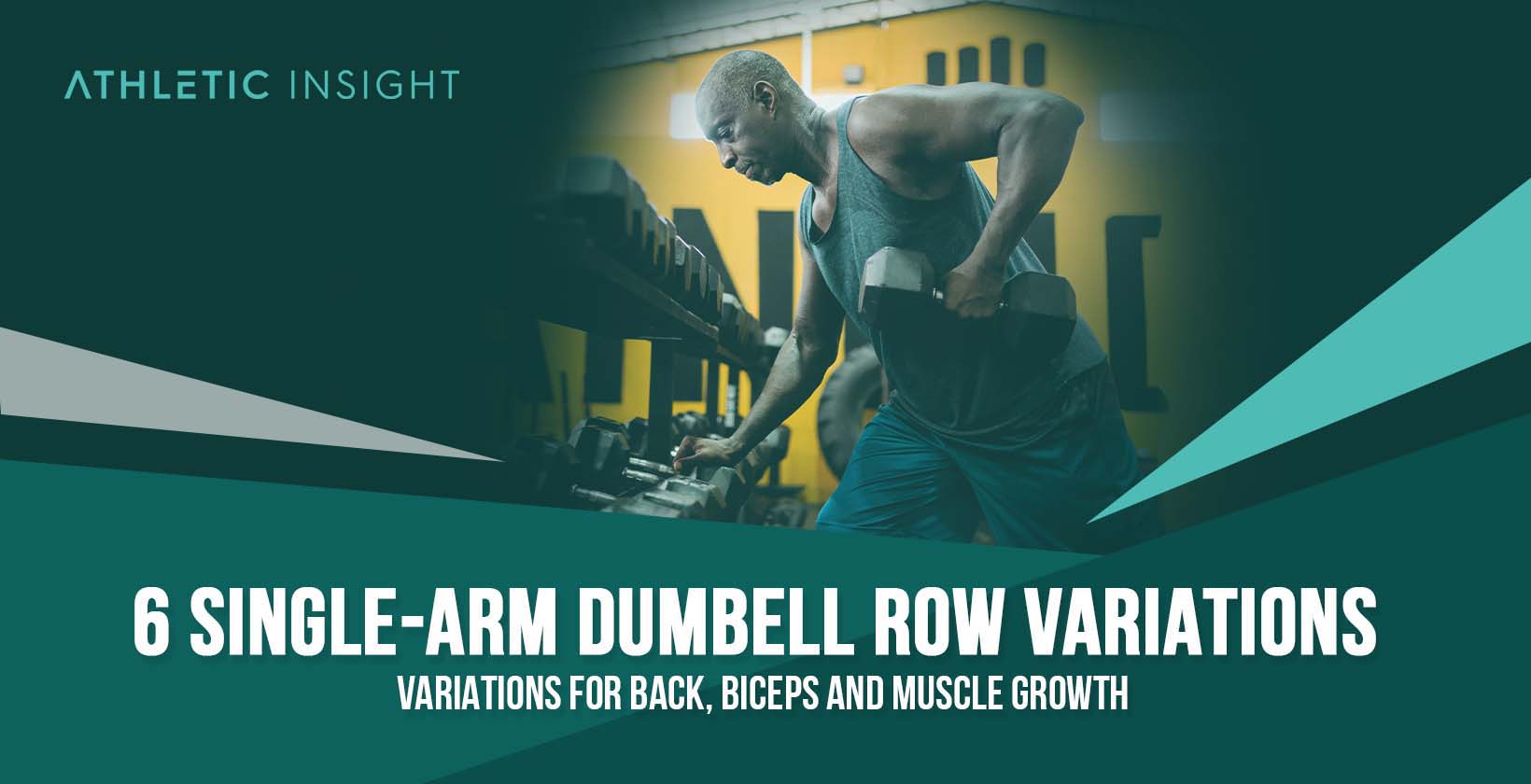A single-arm dumbbell row variation, also know as the one-arm dumbbell row variation, is a weightlifting exercise targeting the forearms, biceps, spinal erectors, scapular stabilizers, and the latissimus dorsi through varying methods from that of the standard single-arm dumbbell row.
While the single-arm dumbbell row is effective for building back, shoulder, and forearm strength all at once, the single-arm dumbbell row variations isolate these muscles and allow for further development. These variations are often seen performed by Bodybuilders, Strongmen, and everyday weightlifters that have plateaued.
The benefits of these exercises go beyond just strengthening your arms. The single-arm dumbbell row variations strengthen your grip and improve the strength of your back. Strength-training your back muscles can naturally improve your posture.
Most variations are difficult for beginners, but can usually be accomplished with less weight. The most common injury is a strained back muscle, but it’s also possible to dislocate your shoulder which is why the form is critical.
1. Kneeling Single-Arm Dumbbell Row
Kneeling one-arm row variations is the most common single-arm dumbbell row variation, targeting the forearms, biceps, spinal erectors, scapular stabilizers, and the latissimus dorsi. Many people may not even consider it a variation. The difference with this dumbbell row variation is that you kneel either on the floor or on a padded weight bench.

Kneeling maximizes the exercise. When you place one knee on the weight bench, it makes it more difficult because of the force of gravity. The kneeling variation works all of the same muscles that the original exercise does, plus it incorporates your hips into the workout.
The exercise also strengthens your core, as you use it to maintain balance throughout the workout, which is a great workout for all people looking to strengthen their upper bodies.
One mistake to look out for is using too much weight. If you use too much weight, your form will break down which is where slipped vertebrae, muscle tears, and joint pain occurs.
To dominate the kneeling single-arm dumbbell row, be sure not to swing the dumbbell by keeping the dumbbell in a straight line and keeping your back straight through the lift. Overall, this exercise is easy to perform.
2. Symmetrical Stance Single-Arm Dumbbell Row
The symmetrical stance single-arm dumbbell row variation is a dumbbell row variation, targeting the forearms, biceps, spinal erectors, scapular stabilizers, and the latissimus dorsi. The symmetrical stance single-arm dumbbell row is performed by standing shoulder-width apart and placing one hand on a bench while you row with the other.
Using only your core, you must maintain your balance while you bend over and do the one-arm rows. The exercise works the same as the original variation, but it allows you to activate the abdominal muscles more.
The symmetrical stance single-arm dumbbell row variation is ideal for bodybuilders who want to increase their weight limits because it focuses on balance and stability. Since you divide your energy and focus throughout your body, the variation results in less muscle growth in your back and shoulders and is considered more of a full-body workout.
One mistake to avoid when doing the symmetric stance single-arm dumbbell row is to ensure your hand is firmly planted on a dry surface. If you have a lot of weight resting on your arm and it slips, you may fall and break a limb or hit your head.
Two suggestions for the symmetric stance single-arm dumbbell row variation are to keep your hand planted at all times to ensure you are not pulling the weight like a deadlift and to use chalk or a wrist wrap if you don’t have the grip strength. Overall, this is an average difficulty variation.
3. Split Stance Single-Arm Dumbbell Row
The split stance single-arm dumbbell row variation is a dumbbell row variation, targeting the forearms, biceps, spinal erectors, scapular stabilizers, and the latissimus dorsi.
A split stance single-arm DB row variation can be done using support or not. Beginners should hold onto a weight rack and bench for support, but advanced individuals may want to do it solo to incorporate more muscle groups.
To do this dumbbell row variation, move one foot forward and one foot slightly back. Concentrate your weight on your toes and balls of your feet. Bend your front knee slightly until you are in a position where you can feel contract your thigh muscles.
When you complete the one-handed dumbbell row in this stance, it engages your entire body, especially your core and upper legs. This exercise works your legs, unlike the other variations that have been discussed. Bodybuilders also use this workout because of the full-body engagement.
4. Decline Arching Single-Arm Dumbbell Row
The decline arching single-arm dumbbell row is a dumbbell row variation, targeting the forearms, biceps, spinal erectors, scapular stabilizers, and the latissimus dorsi.
To perform the decline arching single-arm dumbbell row variation, you create a three-point kneeling position using one knee, foot, and hand. Place your knee and hand on the side not performing the exercise on a padded weight bench, and place your other foot on the floor, putting your weight on the ball of your foot.
The weight bench must be at an angle, with your knee placed on the higher end. You should feel like you are leaning very far forward and slanting downward toward the floor. The angle maximizes the force it takes to complete each row, helping you build more muscle and strength in your shoulders and arms.
Maintaining proper form is critical when performing the decline arching single-arm dumbbell row variation as one false move can lead to a muscle tear or spine damage. Overall, this exercise is best for those with some experience lifting weight. If you are a beginner, use less weight and focus on form.
5. Split Stance Dead Stop Single-Arm Dumbbell Row
The split stance dead stop single-arm dumbbell row variation is a dumbbell row variation, targeting the forearms, biceps, spinal erectors, scapular stabilizers, latissimus dorsi, and the core. This variation is difficult to perform and requires a lot of balance to achieve.
The split stance dead stop single-arm row uses the same positioning as the split stance single-arm dumbbell row variation, but it uses a different method for the actual row motion. This exercise impacts your forearms and engages them in the exercise more.
For this dumbbell row variation, when you bring the row down, allow the dumbbell to rest on the floor for a full moment before lifting it back up. Allow all of the dumbbell weight to rest on the floor for this exercise to be effective. Stopping short of the floor is easier on your forearms than having to pick up the weight off the floor every repetition.
It is critical that you practice good form and do not use too much weight as doing so will place a great deal of pressure on your spine. While this movement does have a few risks, the benefits outweigh the risks when the perfect form is used. Overall, this variation is more of a mid to expert range in terms of difficulty.
6. Birddog Row
The Birddog row is the most difficult single-arm dumbbell row variation that incorporates your shoulders, back, forearms, core, glutes, and calves, into the workout as the balance is a major component of the lift.
For this exercise, you take the kneeling position on a weight bench, as you do with the kneeling variation. The tricky part is the leg resting on the floor is lifted and held straight out. This position mimics a dog pointing at its prey with its tail out, hence how it got its name.
The variation combines yoga practices with weight lifting, forcing your entire body to engage in the exercise. Nearly every muscle group is active during this dumbbell row variation, making it an effective exercise when you are strapped for time.
The risks involved with this variation are heightened as you must rely on perfect balance to maintain the exercise. To prevent injury from falling or pulling a muscle from improper form, it is best to start off with less weight.
What Are the Main Single-Arm Dumbbell Row Exercises Variation Types?
The main variations of the single-arm dumbbell row are the split stance and the kneeling variations. These are popular because they target more specific muscle groups that people want to focus on.

Which Type of Single-Arm Dumbbell Row Variation Is Beginner-friendly?
The kneeling single-arm dumbbell variation is the most beginner-friendly, as you have something supporting you. This one also doesn’t engage your core or lower limbs as much as some other variations do, allowing you to focus your energy and strength on the row itself.
Which Type of Single-Arm Dumbbell Row Variation Is Good For Weightlifters?
The best variation for weightlifters that focus on building strength and getting results is the decline arching variation. While weightlifters do work out their whole body, they want their strength in their upper body, and this exercise focuses on your back, shoulders, and arms.
Which Type of Single-Arm Dumbbell Row Variation Is Good For Athletes?
Athletes can benefit from all the variations, but the best one for sports training is the split stance variation. The split stance images the core while focusing on the arms, back, and shoulders. So you reap the main benefits while still working on your core a bit.
Which Type of Single-Arm Dumbbell Row Variation Is Good For Bodybuilders?
The Birddog is the best variation for bodybuilders. Bodybuilders must perfect and prioritize every muscle group in their body since they are for aesthetics rather than function, unlike weight lifters. The Birddog engages the most muscle groups, ideal for a bodybuilder’s goals.
Which Type of Single-Arm Dumbbell Row Variation Is Difficult To Perform?
The Birddog variation is the most difficult Single-arm DB Row because it requires your core to be fully engaged as well as your lower body. Most row variations do not incorporate the lower body in this way.
By holding out your leg, you must execute balance perfectly as well as arm and core strength, which is much more difficult than just focusing on your arms and shoulders.
Can These Single-Arm Dumbbell Row Variations Be Performed by the Elderly?
Yes, the elderly can incorporate single-arm dumbbell rows into their workout routines. Because these exercises focus so much on back strength, they can be very beneficial to older individuals losing back muscles.
As people age, our posture suffers, but maintaining these back muscles can help keep your posture in good condition. For older individuals, it’s recommended to keep the weight light to avoid strain or injury.
What Are the Alternatives of Single-Arm Dumbbell Row Exercises?
If you’re wondering about single-arm dumbbell row alternatives, there are plenty out there you can do instead of the classic single-arm dumbbell row exercise. While these alternatives work similar muscles, they all have their unique benefits.

- Inverted Row: An inverted row is when you lay under a barbell and pull up your body weight with either both arms or a single arm.
- Seated Row: For seated rows, use a rowing machine or sit up straight and do the rows straight out in front of you with a dumbbell.
- Supported Dumbbell Row: To do a supported dumbbell row, you lay your chest on a bench and do rows with one or two dumbbells. The support takes the pressure off your core, so you focus on your arms and back.
- Warm-Up and Stretching: As single-arm dumbbells row focuses on your back, you can achieve similar results through stretching activities that focus on your back.
- Meadows Row: A Meadows Row uses a barbell resting on the ground rather than a dumbbell. Using the same split stance or symmetrical stance position, you complete the rowing motion with one side of the barbell, leaving the other on the ground.



